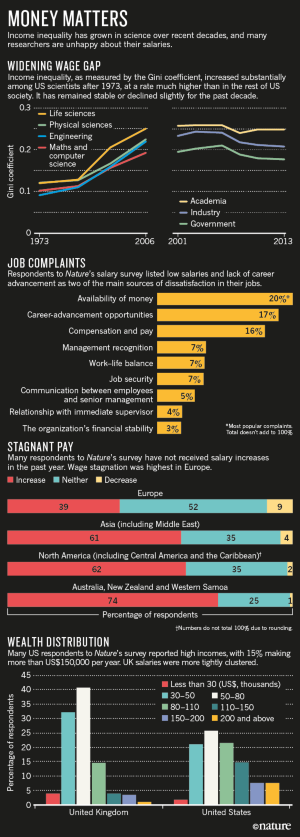Science’s 1%: How income inequality is getting worse in research (original) (raw)
Wages for top scientists are shooting skywards while others are being left behind.

Illustration by Peter Crowther
For a portrait of income inequality in science, look no further than the labs of the University of California. Twenty-nine medical researchers there earned more than US$1 million in 2015 and at least ten non-clinical researchers took home more than 400,000each.Meanwhile,thousandsofpostdocsatthoseuniversitiesreceivedlessthan400,000 each. Meanwhile, thousands of postdocs at those universities received less than 400,000each.Meanwhile,thousandsofpostdocsatthoseuniversitiesreceivedlessthan50,000. Young professors did better, but many still collected less than one-quarter of the earnings of top researchers.

The University of California is far from unique. At universities across several countries, the salary gap between elite scientists and those toiling in the trenches has been expanding over the past few decades, according to labour economists. The inequality mirrors the trend across the rest of society, where stagnating middle-class wages and soaring incomes for the wealthy have created a widening gap between top and bottom earners. The super-rich '1%' is a hot political issue in many countries.
Researchers who study the science workforce say that there is a dearth of data on the salaries of scientists, which makes it difficult to know the full extent and causes of income inequality. But the gulf in wages has reached a point at which it could be driving talented young people away from careers in academic science, says Richard Freeman, an economist at Harvard University in Cambridge, Massachusetts. The results of Nature's 2016 salary survey support that concern. More than half of 3,600 respondents say that they have sacrificed a good salary by going into science, and nearly 20% would not recommend that students pursue a career in scientific research.
The problem shows no sign of disappearing. “With more competition and fewer rewards, it makes income inequality much more intense,” says Freeman.
Inequality index
When labour economists measure disparities in salaries, one of the metrics they use is the Gini coefficient, named after an Italian statistician who developed the measure in the early twentieth century. A coefficient of 0 means that everyone earns the same. A value of 1 indicates maximum inequality — everyone earns nothing except for one person.
In her 2012 book How Economics Shapes Science (Harvard University Press), economist Paula Stephan at Georgia State University in Atlanta calculated the Gini coefficient for science and engineering faculty members at US doctorate-granting institutions, using salary data from the US National Science Foundation's Survey of Doctorate Recipients. She found that the Gini coefficient more than doubled between 1973 and 2006 in most fields and faculty ranks, with the biggest increases in the life sciences (see 'Money matters'). By contrast, it grew by just 35% for full-time male earners in the United States and by only 18% for US households. The faster increase among researchers probably stems from the fact that wages in science have historically been more equal than for other sectors of the economy and are now spreading out, says Stephan. In 2006, the Gini coefficient for science professors ranged from 0.14 to 0.25, depending on discipline and rank; for households in the United States, it was 0.47.

Source: P. Stephan How Economics Shapes Science (Harvard, Univ. Press, 2012); Z. Liqun, R. Freeman NSF Survey of Doctorate Recipients; 2016 Nature salary survey
To find out how wage gaps in science have changed in recent years, Nature worked with Freeman and Zhuge Liqun, a research assistant at the National Bureau of Economic Research in Cambridge, Massachusetts, to calculate Gini coefficients from the National Science Foundation's survey data. The analysis suggests that inequality decreased slightly in 2008. Since then, however, the gaps seem to have remained relatively large and stable, with academia showing wider spreads than industry and government.
One factor that could have fuelled part of the rise over recent decades in the US biomedical sciences is the doubling of the National Institutes of Health's budget during the late 1990s and early 2000s, says Stephan. As new research buildings sprang up across the country, institutions needed to fill them with productive scientists who could bring in grants. This created competition among institutions for a small pool of top-ranked, grant-winning scientists, and that probably drove up their salaries, she suggests.
“Science is risky and expensive,” says Donna Ginther, a labour economist at the University of Kansas in Lawrence. “One way for universities to minimize risk is to pick someone who is a demonstrated winner.”
In the United Kingdom, too, the salaries of top-earning professors have been pulling away from the pack since the late 1990s, says Ben Martin, a science-policy researcher at the University of Sussex near Brighton, UK. Back then, the highest salaries were roughly twice that of the nationally agreed minimum value set by unions and employers, he estimates. Now that factor has ballooned to more than seven, according to 2013 data from the UK Higher Education Statistical Agency. Growing competition for good researchers from around the world has helped to boost faculty salaries in the United Kingdom, says Martin. “It's become a much more global market in which universities operate.”
The regular evaluation of research quality at UK universities, the Research Excellence Framework (REF), could also be bumping up salaries, adds Martin. The assessment, done by UK funding agencies roughly every five years, determines the amount of research money that universities receive from the government. Universities are evaluated in part on the quality of their researchers' publications up to a certain 'census' date. Faculty members who were hired just months or even days before this date are included in the assessment, and so are their publications from the past six years. This gives universities an incentive to recruit researchers with strong publication records as the deadline for the assessment approaches, as a way to boost their REF scores, says Martin.
With more competition and fewer rewards, it makes income inequality much more intense.
An analysis of UK full-professor salaries posted online in July suggests that some universities — particularly lower-ranked ones that want to improve their REF performance — are using high salaries to recruit researchers with high-quality papers to boost their scores (see go.nature.com/2cwnyjj). Gianni De Fraja and his colleagues at the University of Nottingham, UK, showed that departments with higher average pay for full professors in 2013 got better REF funding scores in the 2014 assessment. “Our data suggest that universities are buying CVs in the run-up to the REF,” De Fraja says.
The competition to lure — or keep — star scientists is raising wages in other countries, too. In China, various government-sponsored initiatives to boost research excellence have been using high salaries to recruit leading researchers, according to Qi Wang at Boston College in Massachusetts, who studies research universities. In Germany, faculty salaries are more regulated than those in the United States or United Kingdom, but some of those restrictions have been loosened in the past decade or so, says Ulrich Teichler, a higher-education researcher at the University of Kassel in Germany. Many professors can now use good performance to negotiate larger pay rises than before, he says.
In the United States, wage gaps are easy to spot in databases for some public universities, such as the University of California. But top professors can earn considerably more at the elite private universities, which are not required to report their wage data to the public. In response to a question from Nature about how the salaries of its highest-paid professors compare with those elsewhere, the University of California said that “faculty at the University of California are, by and large, paid less than their peers at comparable institutions”. The state has faced major budget pressures over the past decade.
Bottom bracket
At the other end of the salary spectrum, there is little pressure to boost pay. With grants getting harder to win, labs rely on a large, low-cost workforce to maximize research output, says Gary McDowell, a former postdoc and now the executive director of the Future of Research, a non-profit organization in San Francisco, California, that advocates for young scientists. This labour environment benefits from the willingness of postdocs to sacrifice income for a chance at an academic research career, he says. Even those lucky enough to land offers for tenure-track junior faculty positions find that starting salaries are not very negotiable, say researchers. Instead, they focus on trying to get bigger start-up packages for their new labs.
The culture among researchers helps to keep salaries low because scientists tend to value discovery much more than financial gain, says McDowell. “People don't go into this for money,” he says. “We want a rewarding job that uses our passion for science. But that gets taken advantage of.”
The growing ranks of non-tenure-track faculty members — such as adjunct professors hired to teach students — may also be contributing to low wages, says Stephan. They are paid much less than assistant professors or even postdocs. McDowell says he is seeing a growth in these kinds of positions in science, which are often taken by people who want to hang on in academia in the face of dwindling career prospects there.
Income inequality can be good and bad, says Julia Lane, an economist at New York University who studies the research workforce. High salaries at the top can attract productive workers, but low pay at the bottom can signal that there may not be a good future in this career. More than 60% of respondents to Nature's salary survey said that their job prospects were worse than those of previous generations, with that pessimism running at around 70% in North America and Europe. And just over half of respondents around the world reported that they had received a salary increase in the past year.
Income inequality seems to have little effect on overall research performance, says De Fraja. In his analysis of UK faculty salaries, he found no correlation between the spread of professors' salaries in departments and their REF performance. Egalitarian and elitist departments seem to do just as well.
But too much inequality could cut many academic careers short, says Ginther. If big rewards become concentrated in the hands of a smaller number of people in a highly competitive area, then many others who could still have been productive scientists end up losing a disproportionate amount in terms of earnings and career prospects. That could keep promising people from further pursuing a research career, says Ginther. “You're discouraging a lot of potential scientific discoveries.”
Freeman says that how much more people should be paid for better performance is an open question. How steep should that incentive curve be in science? “It's by no means clear that we have the right steepness,” he says. “The danger today is that it's steeper than it should be, too steep to be efficient.”
One key problem is that not enough is known about where scientists with PhDs end up in their careers and what their salaries are, says Lane. Without this kind of information, young scientists often find themselves making important career decisions on the basis of erroneous assumptions about pay, says Keith Micoli, director of the New York University School of Medicine Postdoctoral Affairs. He says that some postdocs are surprised and disappointed when they find that a starting salary for a long-sought job may not be as high as they had hoped.
So Micoli advises postdocs to do the research themselves: find people who are doing the jobs they are interested in and ask them what they earn. That's what Harvard postdoc Rebeccah Lijek did when she entered the job market for a faculty position last year. She says that she benefited from her network of contacts, getting details about what she should expect as a fair salary and what size of start-up package she would need to set up her immunology lab. Someone without the kind of contacts and mentorship she had could be at a disadvantage when trying to negotiate compensation, says Lijek. “It's really about who has the privilege to have this information.”